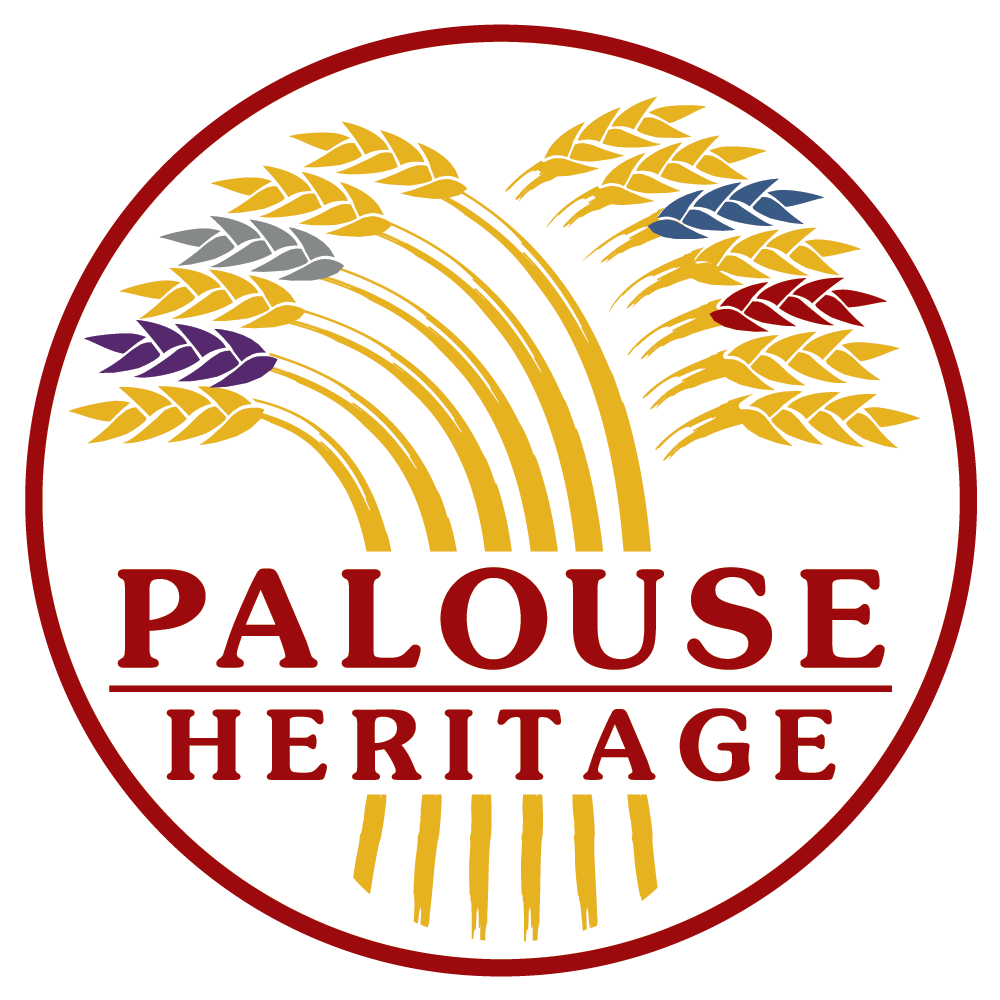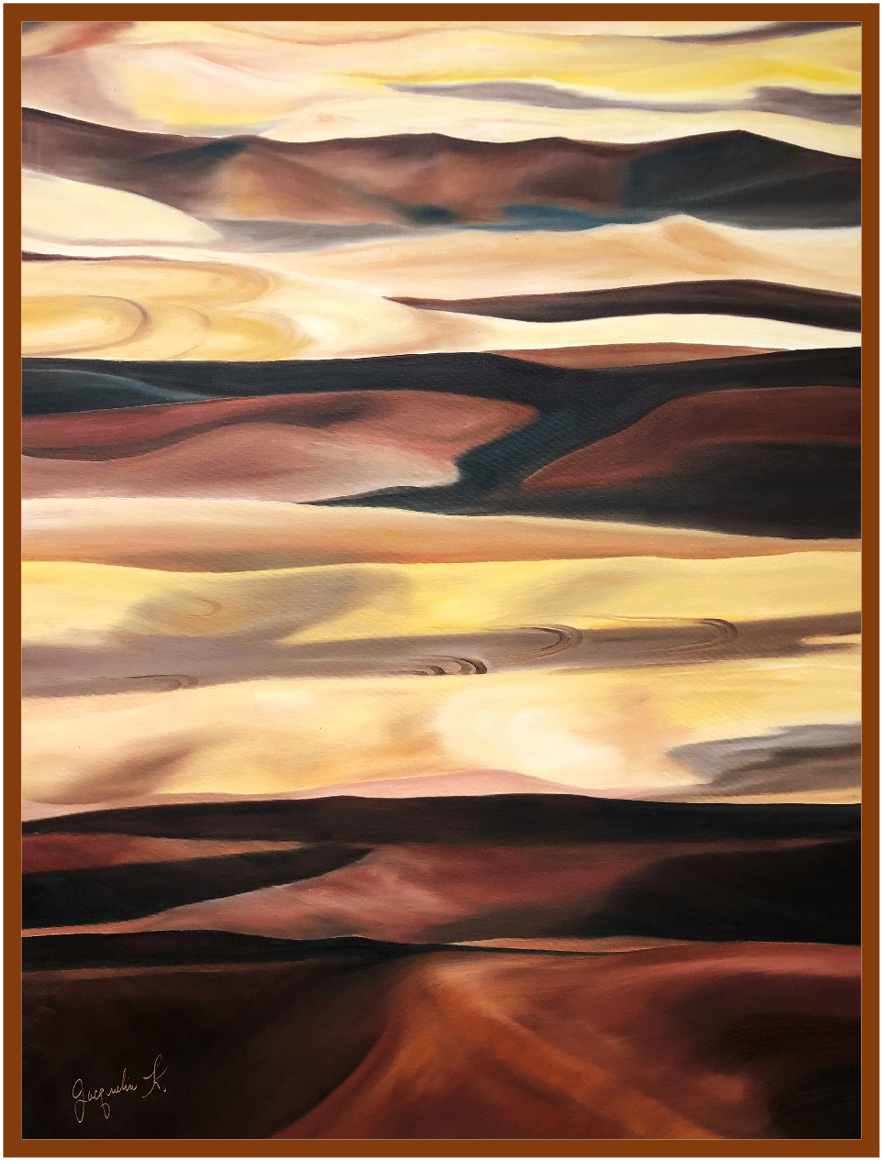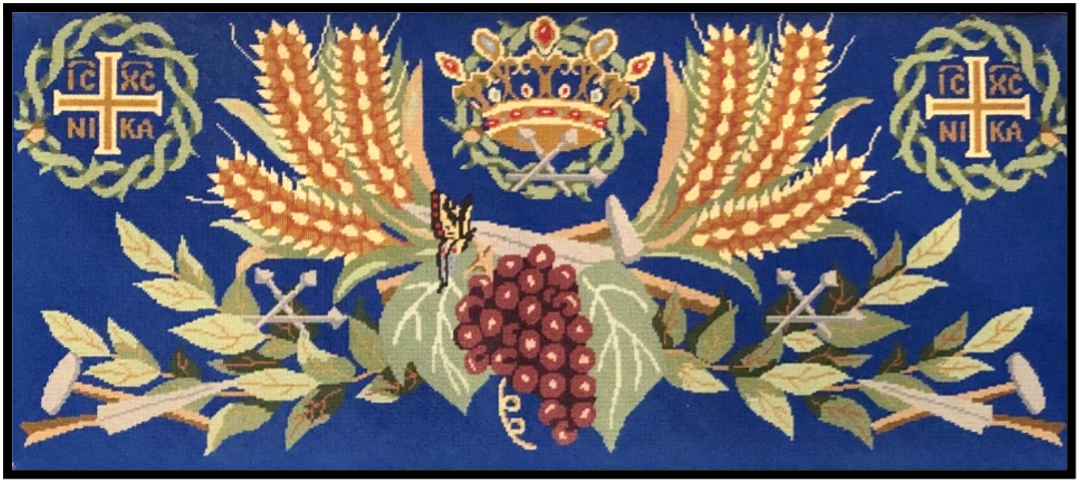Jacqueline Daisley, Palouse Hills—End of Harvest (2018), Oil on canvas, 42 ½ x 32 inches, Columbia Heritage Collection
Recent Palouse Country fine art exhibitions that have explored themes of food security and agrarian landscapes have been sponsored by the Pullman Arts Council, Moscow Arts Commission, and Colfax Arts Council. They have featured works by George Bedirian, Vicki Broeckel, Anna Blomfield, and by Jacqueline Daisley, who lives on a farm near Pullman where the surrounding countryside inspired her curvaceous masterpiece, Palouse Hills—End of Harvest. Anna Blomfield embarked on an artistic farrago in the fall of 2006 to explore and depict Palouse grain production throughout the seasons. The British newcomer had studied painting and printmaking at St. Martin’s School of Art in London and in Liverpool before moving to California in 1987 to work as an animator and muralist. Her popular online “frogblog cartoondiary” commenced on November 7, 2006 when she observed, “If I wanted to buy a combine harvester there are 3 dealers in town to choose from.” Blomfield, whose family had operated a farm implement business, first applied her special interest in the venerable forms of manual labor to paintings of foundry and tannery workers.
Relocation to the Northwest brought unexpected agrarian vistas and serendipitous friendships with area farmers, combine dealers, shop mechanics, and others engaged in agricultural pursuits. “I was entranced with the landscape, the people, and the various crops” she remembered; “each one had a story to tell and show.” Over the course of her five-year residence in the region, these encounters yielded dozens of such colorfully illustrated posts as “Out Amongst the Wheatfields (8.28.07),” “Threshing Bee (9.3.08),” and “A Combine Chorus Line (4.25.2010)” with commentary provided by the artist’s alter ego Froggie who traveled year-round in Studio Subaru. Characterizing her captivating genre as “visual storytelling,” Blomfield combined illustration and information to transport and amuse readers through expeditions to harvest fields, grain elevators, inspection stations, rural railroad sidings. Public “gallery” showings of her popular work were appropriately held in repurposed silos, barns, and the farm equipment dealerships she had first noted in her earliest online posts.
Henry Stinson, Untitled Wall Mural (2019), Fonk’s Store Mural; Colfax, Washington
Columbia Heritage Photograph
Pullman, Washington, artist Henry Stinson has painted beautiful representational canvases of harvesting combines and other modern farm equipment in action, but is especially known for whimsical views that reflect his lifelong fascination with gadgets and electricity that attest to modern American society’s ubiquitous connections to technology. An enormous untitled Stinson 2019 exterior wall mural looks as if American Gothic appeared in an 1960s episode of Lost in Space. The painting reflects the artist’s interest in a world where people and livestock increasingly share rural landscapes with with drones and satellite-controlled, computer-monitored field equipment. The work may also suggest dehumanization of the countryside as well as frayed intimacy and responsibility to landscapes.
Disturbing provocations have long been essential work for artists and authors who question popular assumptions about the benefits of innovation and globalization while trying to preserve what should not change. Shapes and names of the surreal artwork of contemporary Canadian painter Jo-Anne Elniski reflect rural environmental concerns. The Last Harvest depicts a fulminating sky in vivid swirls of yellow, purple, and white that rain down upon rows of grain that wave in the same garish colors. Other works by Elniski like Field of Gold and Prairie Harvest appear as flaming fields of abundance that rise to confront brightly lit horizons of pink, orange, and yellow. The depictions are awesome if unsettling. Yet concerns expressed through art and literature also present opportunities for reconsideration of assumptions, intervention, and progressive change. Such reconsideration is a principal theme of Indian author-anthropologist Amitav Ghosh’s 2016 book The Great Derangment. Ghosh’s ecumenical survey of world literature from the Epic of Gilgamesh and the Odyssey explores storytelling as commentary on natural resource extraction and climate change. He holds authors and artists of the modern era as culpable as politicians and economists for a collective failure of imagination to express an unfolding “derangement” of natural systems, social stability, and food production.
A disturbing scenario of consequences resulting from such dislocation is the subject of Uncertain Harvest (2021) by Vermont sociologist Charles Simpson (1941-2021). The novel relates American journalist Ed Dekker’s hazardous global quest after uncovering evidence at a European biotech conference of minacious environmental and food security risks wrought by transnational agribusinesses. Dekker finds that the company “Naturetek” and others exert unprecedented control of the university and government research sectors and develop genetically engineered terminator seeds that produce sterile offspring and compel grower reliance on their patented germplasm. The engaging story draws on Simpson’s own experiences working with farmers and indigenous peoples in Mexico and Guatemala and investigation of U. S. government subsidies, lax regulation, and global trade policies that are inimical to small-scale sustainable farming and regional rural development.
I first learned about the scope of GMO commercialization in 2012 while traveling from Seattle to a global orphan care conference in Indonesia. I noticed the logos of prominent U. S. seed suppliers on the shirts and backpacks of other passengers on the Tokyo to Bali connection. I spoke with several while waiting for our bags at the airport and learned that the Asia & Pacific Seed Association Conference was also taking place that same week at the city’s posh Legian Seminyak Resort. During a break in the meetings I was attending in more humble surroundings, I ventured across town to the seed conference and met security befitting the visit of a head of state. After considerable effort and the intervention of delegates I had met on the plane, I was finally admitted. A combination trade show with large group presentations, the forum provided an opportunity for transnational agribusinesses like Sygenta, Bayer, and Monsanto to showcase proprietary seeds and technologies that I was told could “transform” Asian agriculture.
Small Farmer’s Journal 45:2 (November 2021)
Cover Photo: Measuring a Case thresher operating speed
One of the influential contemporary voices on small-scale sustainable farming and rural culture is painter-farmer-author Lynn R. Miller of Sisters, Oregon, who has written over twenty books of nonfiction, fiction, and poetry. In publication since 1976, Miller’s quarterly Small Farmer’s Journal reaches 20,000 readers and features articles on a wide range of topics for farmers and ranchers devoted to the “craft” of farming and husbandry and for those interested in the life and literature of the countryside. He decries industrial agriculture as well as trivialized boutique “fad” farming. The Journal has featured numerous harvest-related articles including Esther M. Jensen’s c. 1940 Willamette Valley memoir, “The Day the Threshers Came,” equipment reprints like H. R. Trolley’s “The Efficient Operation of Thrashing Machines” from a 1918 USDA Farmer’s Bulletin, and detailed accounts by twenty-first century operators of horse-drawn reaper-binders and stationary threshers like Khoke and Ida Livingston of Davis City, Iowa (“The Harvest of Grain”). Miller’s photo essay “Anatomy of a Threshing” (2021) is a prelude to forthcoming books, “Threshing Machines” and “Grain Binders and Reapers,” which will be the culmination of his years-long mission to glean practical information from out-of-print books, manuals, parts lists, and catalogs.
Miller describes the Journal as more of a “community odyssey” than periodical. In a recent editorial titled “Seedbeds & The Rooted Mend,” he recalls visiting a local high school where he was asked to speak about farming. “I told them, no I tried to show them, that the small s big F—small Farming—the one where the farmer is the measure—contains every single element of life, most every attainable pedestal of adventure, and the best chance at everlasting health.” Perhaps spurred by the immediacy youthful hearers, Miller then mused about the significance of their high desert homeland: “To take root here is to find and see the elements, wind, sun, trees, wildlife and our own meddlesome footprints as belonging. You do that in part by keeping sight of what is near at hand, by being ‘short-sighted.’ If you are looking off to imagined holiday vacations, to deep seedy city environs, to video fantasies, to cosmetics in pursuit, to worrisome accounting, you will NOT see yourself rooted, you will NOT see the other elements near you as rooted.” In closing Miller expressed hope that his enduring effort at “community journalism” had provided “a soft drumming of information, shared adventure, and kinship” to support, celebrate, and gather the vital assembly of “human-scale,” small farmers.












